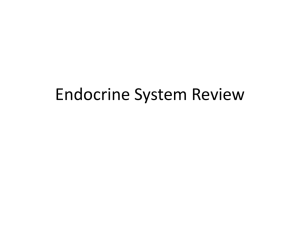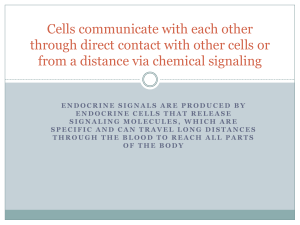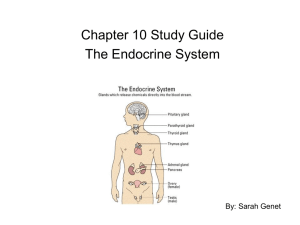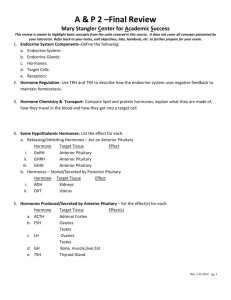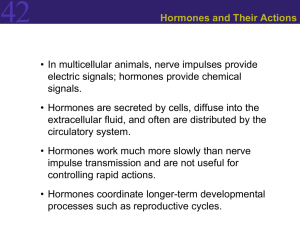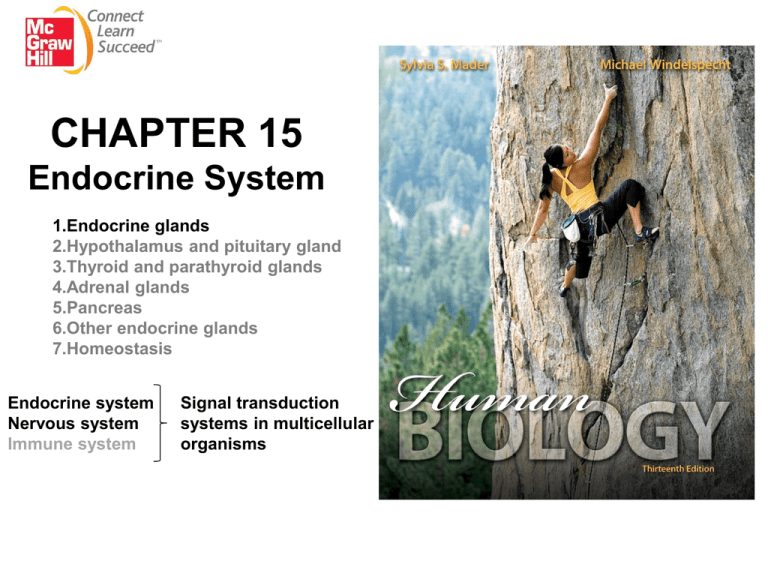
Title
CHAPTER 15
Endocrine System
1.Endocrine glands
2.Hypothalamus and pituitary gland
3.Thyroid and parathyroid glands
4.Adrenal glands
5.Pancreas
6.Other endocrine glands
7.Homeostasis
Endocrine system
Nervous system
Immune system
Signal transduction
systems in multicellular
organisms
15.1 Endocrine glands
Fig. 15.1 The action of neurotransmitter differs from that of a hormone.
Common points: to use chemical signals (and the receptors) and maintain homeostasis.
Different points:
structural
transmitter
method
speed
components substances
Nervous system
neurons
neurotransmitters axons & synapses rapid
hormones
blood streams
slow
Endocrine system glands
liver cell
liver
insulin
Portal vein
axon of
nerve fiber
b. Reception of insulin, a hormone
pancreas
arteriole
vesicle
axon terminal
neurotransmitters
a. Reception of a neurotransmitter
心臓→大動脈→動脈→細動脈→毛細血管→静脈→大静脈→心臓
心臓→大動脈→動脈→細動脈→毛細血管→静脈→毛細血管→静脈→大静脈→心臓
門脈
腸管動脈→毛細血管→静脈→毛細血管→肝静脈→下大静脈
Fig. 15.2 The endocrine system ( classical )
Hypothalamus
視床下部
Pituitary Gland
Posterior pituitary
Anterior pituitary
Recently identified
endocrine systems
vessels (artery) 血管
heart 心臓
fat tissue 脂肪組織
stomach 胃
Parathyroids
下垂体(前葉、後葉)
副甲状腺
parathyroid glands
(posterior surface of thyroid)
Thymus
胸腺
Thyroid
甲状腺
Pancreas
膵臓
Adrenal Gland
Adrenal cortex
副腎
副腎皮質
Gonads
Testes
Ovaries
性腺(精巣、卵巣)
testis
(male)
ovary (female)
Table 15.1
松果体
Hypothalamus-pituitary-peripheral endocrine system
Hypothalamus
Releasing:
Inhibiting:
Pituitary
posterior pituitary
hormoneproducing cells*
Hypothalamic hormone-producing cells
CRH
ACTH
producing cells
TRH
GnRH
(=LHRH)
GHRH
GHIH
(Somatostatin)
(PRF)
PIH
TSH
LH/FSH
GH
PRL
producing cells producing cells producing cells producing cells
ADH
#not
Lower
endocrine
systems
OT
included in
posterior pituitary
hormones
Aderenal
cortex
Thyroid
Gonads
cortisol
T3,T4
sex
hormones
IGF-1
sex organ etc
bone etc
whole body
whole body
Liver
Whole
body
Mammary
gland
Exocrine versus Endocrine (p334)
Differences: with/without duct(s), cell polarity
膵内分泌
Duct(s)
Negative feedback (p335)
Fig. 15.7 Negative feedback mechanism in the endocrine system.
hypothalamus
releasing hormone
(hormone 1)
TRH
甲状腺刺激ホルモン放出ホルモン
TSH-releasing hormone
anterior pituitary
stimulating hormone
(hormone 2)
TSH
甲状腺刺激ホルモン
Thyroid stimulating hormone
target gland
Thyrotropin
target gland hormone
(hormone 3)
Thyroxine, triiodothyronine
甲状腺ホルモン
Thyroid hormone
feedback
inhibits
release of
hormone 1
TRH
feedback
inhibits
release of
hormone 2
TSH
Receptors (p336)
Fig. 15.3 Hormones target specific cells.
androgen receptors
XY
nontarget cell
receptors
target cells
androgen
hormone
XY
capillary
normal:男性への性の分化
Androgen insensitivity (p336)
Fig. 15.3 Hormones target specific cells.
XY
target cells without the receptor
XY
androgen
capillary
receptor abnormality:
男性への性の分化異常
↓
女性型
Local hormones (p336)
e.g., prostaglandins and growth factors.
Prostaglandins are produced, but not carried elsewhere in
the bloodstream.
endocrine
paracrine
autocrine
The Action of Hormones (p337)
Peptide hormones
ペプチドホルモン
インスリン
Steroid hormones
ステロイドホルモン
アルドステロン
Amino acid-derived hormones
アミノ酸誘導体ホルモン
アドレナリン
Fig. 15.4 Action of a peptide hormone.
capillary
1. Hormone binds to a
receptor in the plasma
membrane.
peptide hormone
(first messenger)
activated receptor protein
enzyme
親水性ホルモン
↓
膜受容体
2. Binding leads to
activation of an
enzyme that changes
ATP to cyclic AMP.
cAMP
plasma
membrane
ATP
(second messenger)
3. cAMP activates an
enzyme cascade.
4. Many molecules of
glycogen are broken
down to glucose,
which enters the
bloodstream.
glucose
(leaves cell
and goes
to blood)
glycogen
Fig. 15.5 Action of a steroid hormone and amino acid-derived hormones.
steroid
hormone
1. Hormone diffuses
through plasma
membrane because
it is lipid soluble.
plasma
membrane
cytoplasm
脂溶性ホルモン
↓
核(細胞質)受容体
=転写因子
nucleus
2. Hormone binds
to receptor inside
nucleus.
protein
DNA
receptor
protein
mRNA
3. Hormone-receptor
complex activates
gene and synthesis
of a specific mRNA
molecule follows.
ribosome
mRNA
4. mRNA moves to
ribosomes, and protein
synthesis occurs.
夏休みに分子生物学を体験してみませんか?
ゲノムを抽出する。
プラスミドを扱う。
RNAを抽出する。
制限酵素で遺伝子を切ってみる。
PCRで遺伝子を増幅してみる。
・
5日コース
8月18-22、25-29日
興味があれば、原研分子医学・永山まで
(nagayama@nagasaki-u.ac.jp)
〆切:7月4日
百聞は一見に如かず
Seeing is believing
百見は一触に如かず
Experiencing is believing
↓
2年生になったら、1年生を指導


